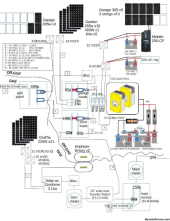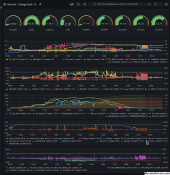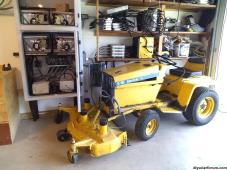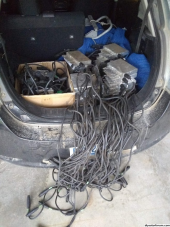Note: Over the last three years I have tested so many combinations of devices you would not believe.
Starting with a computer UPS that 4 different electricians said would not work.
What I have distilled is our best observations, that we have shared, over that time.
OK, so the Micro-Inverter directly connected to battery is still running fine, right?
_Yes that is correct
Assuming ~95% efficiency of your Micro-Inverters, 200WAC out requires 210WDC in which is 8.4A @ 25VDC.
_I don't bother working out efficiency.
_With Micro-Inverters I just add more panels if I need more juice.
Would appreciate it if you could provide your Micro-Inverter model or better yet, tell us what it’s maximum input current rating is…
_Enphase M215 is the main model I use.
_Maximum input current is 10.5A
https://www.adelaidesolarsafe.com.au/docs/enphase/Enphase_M215_Micro_inverter.pdf
300WAC out requires 315WDC in or 10.5A @ 30VDC out of your voltage booster.
_Yes that is correct.
_Initially I bought the Boost Converters to "control" the current because articles on DIYSolarForum & other places said connecting directly to the battery would fry the Micro-Inverters.
_After buying 3 boost converters I thought I could replicate the above on all three but I could not get any two adjustments the same.
_I tried about 4 different types of cheaper type Boost Converters (up to about AUD $95) but they all had some sort of issue. (Usually adjustment)
_There is certainty in my mind that there may either be a more expensive type of Boost Converter out there that will do the job (I have seen some) or a much better sub $100 Boost Converter will soon be available.
_In the end I tried connecting one Micro-inverter directly and it worked. Talk about the hard way!
And if the booster has efficiency of ~95%, the booster is taking input power of 332W = 13.3A @ 25VDC from the battery.
_Your calculations are correct.
_I don't bother working out efficiency. I did it a few times but I don't see the point.
_With Micro-Inverters I just add more panels if I need more juice.
Sounds like you are either using two different Micro-inverters or perhaps you are pumping the battery voltage up to higher than 32VDC???
_There are 4 different types of micro-inverters on our roof 3 x Enphase 1 x SunnyBoy
_M215's are all I have used for no particular reason. (I got a box of 40 of these M215's for $30 Each brand new)
So you’ve been running both direct-connect and through-booster configurations for over two years now and both have worked fine over that period of continuous use.
_That is correct
Since the booster was not needed, adds complexity, and reduces net efficiency, you’re going to convert that boosted setup to direct-connect as well.
_I did not say "reduces net efficiency" but the Boost Converter runs relatively warm. Add in the reasons outlined above & you can see our train of thought.
_Adjusting the current crop of Boost converters is too hard for a lot of people and more mistakes can be made.
_With our setup of two timers per battery I can run one Micro Inverter for 14 hours. Then if the battery deteriorates I can set the second timer to turn off inside the point where our battery protector kicks in.
_This gives us 3 levels of "protection" ...A. The Timer(s) ...B. The Victron or MotorMate Battery Protector ...C. The BMS on the battery itself
Have I understood all of that correctly?
Hopefully this question is answered.
Our mantra has always been:
To make it simple (using off the shelf parts) so any one can contribute to reducing global warming.
(One battery with a MicroInverter dramatically increases Energy Independence.)
Simple Setup:
Battery Side: Battery & Charger + Fuse
Inverter Side: Battery Protector, Timer, Inverter + Fuse
The reason my wife & I went this way is part of our contribution to reducing CO2 & empower others to do the same.
We could have bought a Tesla Battery but most people cannot afford that & are severely inhibited whilst trying to contribute.
Our system is designed to use the inevitable flood of batteries from electric cars etc.
If you want to start at 48Volt batteries I am thinking it might be best to use the - IQ7Plus.
They can go as high as 60V.
View attachment 143092View attachment 143093
View attachment 144758
B









